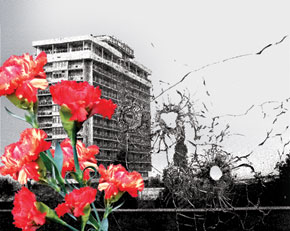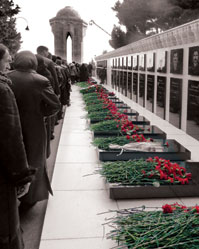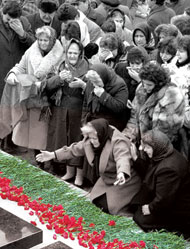Childhood memories
Twenty three years ago, carnations used to be favourite flowers in every Azerbaijani family. Red, white, pink – they were all colours of joy and happiness. Carnations were my family’s favourite as well. Whenever we went to visit someone, my Mum would always take five or seven red carnations for our hosts. And regardless of visitors, it was so nice to have flowers in a vase on a table at home, brightening up the place. For the last 23 years though, it has all been very different. Carnations have become a symbol of mourning. No young couples can be seen anymore carrying a bouquet of carnations. Everything changed in a single day – from a sign of love and happiness carnations became the bearers of mourning and grief.
Even numbers, not odd
When I was a child I used to ask my Mum why she bought five or seven carnations, never three or six. She explained that this was because even numbers of flowers are usually used at funerals. Who would have known that from 20 January 1990 carnations would be used only in even numbers, never odd? So sad, as they are lovely flowers.
Like the date, which has been given the name Black January, the carnation has acquired a black label too. I was 11 years old when it happened. We lived at that time on a street near Hilltop Park, parts of which were to become Martyrs’ Avenue. My Mum often took me to the attractions there. After 20 January 1990 we never went there for fun again. We went to honour the dead. The victims of Bloody January and later the martyrs of the Karabakh war were buried in the Hilltop Park, which became Martyrs’ Avenue or Shehidler Khiyabani.
Red and black
In my childhood memories there is a picture of that street buried in black and red. The black was people carrying hundreds of corpses and the red was the carnations piled on top of them. There was a strange hum in the atmosphere. It was the cry of men and women grieving for those who had been crushed by the Soviet power machine, or by tanks, or hit by machine-gun fire or simply beaten to death with a rifle butt. All their coffins were carried on the shoulders of the crowd. The whole country seemed to have gathered on that street. There wasn’t an inch of space free. Everything was covered in black and red.
The flowers came mainly from Mashtagha, a village just outside Baku which used to be known for growing carnations. After those bloody events demand for the flowers fell and Mashtagha no longer has its huge carnation fields. Now, there is only one day in the year when carnations are in huge demand – 20 January.
A toy gun versus the real thing
I remember the night of 19-20 January. At first TV and radio were off air and people were left without news. We heard from neighbours and relatives in different parts of the city who kept calling to update us about the situation on their street. Then the phone was disconnected and we were completely cut off. The only sound was the approach of tank tracks and whizz of bullets which made us think that something terrible was coming to Baku.
I remember the fear in the eyes of my parents who kept shouting at us children not to go near the windows. The next day our neighbour told us that a little boy had been shot on a balcony playing with his toy gun. It seems the Soviet soldiers decided to teach him a lesson not to play with a toy gun when the real thing was around. A few days after that tragic night, as I held Mum’s hand at Martyrs’ Avenue, I looked for the boy’s grave. I didn’t find it but saw many other small graves. There was Larisa Mammadova, a 13-year-old schoolgirl. I remember her grave well because of the brown school uniform that used to be worn by schoolgirls at that time and the red pioneer neckerchief, the symbol of Soviet pupils. The uniform hung over Larisa’s grave and its red neckerchief hurt my eyes. A red checked coat hung over the grave as well. That night she was on a bus with her father. The bus came under fire and one of the many bullets shot Larisa straight through the heart. Her father survived, but only physically. His love for life died with his daughter.
Every grave a human story
I also remember the graves of two young people, not long married. His name was Ilham, hers was Fariza. They got married just six months before the tragedy. That night claimed Ilham’s life when he and other young people tried to help the injured. Fariza passed away soon afterwards. She couldn’t bear to be without Ilham and poisoned herself. That sad love story spread instantly throughout Azerbaijan. Years later, when I was in the seventh grade, I would loudly recite a poem about Ilham and Fariza before the school on 20 January.
Every grave in Martyrs’ Avenue is another human story. Black January took lives without respect for age, gender or social status. All of them are heroes in the fight for Azerbaijan’s independence. The grave of 50-year-old Nariman Allahverdiyev could tell you that as a street sweeper he helped to clear the bodies from the streets. Three days later he died of a broken heart; unable to stand what he saw, his heart stopped.
As a child I was most shocked by the story of Farida Abbasova who was shot and killed instantly as she hung washing on her balcony. She had three children; in an instant they lost their mother. It was difficult for me to imagine myself in the place of those children. A terrible thought.
Perhaps my Mum felt the same as me as we looked at Larisa’s grave. Perhaps she was imagining her child in Larisa’s place as tears rolled down her cheeks. The same pale face of a girl and red-checked coat remained before everyone’s eyes. Gulam Shukurov often remembers the red-checked coat as he was a witness to those tragic events. He recalls how he was standing at a bus stop that night at 11.00 p.m.
The bus came. I got on with the other passengers. As we approached Chapayev Street, the bus suddenly came under fire. I was wounded in the leg. People began to panic, some of them started to get out of the bus. But as they were getting out they were shot and killed. The driver was killed instantly. I remember a soldier got on the bus. He went up to the corpse of the girl in the red-checked coat. He kicked her leg and muttered ‘Bitch’. It was horrible to watch.
Bloody memories
There are recollections from hundreds of witnesses who survived that night. Here are several recorded by journalist Tatyana Chaladze.
From the testimony of Mardakan resident Abbas Abbasov:
On the evening of 19 January, I was going home. I saw a group of people in the street. They were talking and then I saw tanks approaching the group. Suddenly the tanks started shooting at the people. I was wounded in the leg. I couldn’t believe it and even when I was asking soldiers from the tanks to help me, they started to beat me till I lost consciousness.
Nadir Aliyev from Baku recalls how he and his brother drove to the airport.
My car came under fire that night on the road to the airport. I got four bullets. I saw people running along the roadside and soldiers shooting them in the back. When the soldiers came close to my car I had a good look at them. Their faces were different from usual soldiers. They had long hair, moustaches and beards, but they were dressed in military uniform. They were aggressive to everyone.
Rufat Hasanov was studying at the Azerbaijan Technical University. On the evening of 19 January, he visited relatives in Baku’s Musabekov district. As they heard the noise of approaching tanks they ran to the square. We saw dozens of tanks with five or six soldiers holding machine-guns standing on each of them. When we got about 150 metres away from the tanks the soldiers started to shoot, first into the air then suddenly at people. We couldn’t run away. I was wounded in both legs and don’t remember how I got to hospital where doctors operated without electricity, just by candlelight.
Rovshan Logmanov was one of the volunteers helping the wounded that night.
I was near the Amirjan roundabout on the road to the airport when I heard the cries of people running from the tanks. I saw a car on the road with wounded people inside. My friends and I went towards the car to help the wounded, but a group of soldiers appeared in front of us and ordered us not to help. At this moment I saw a tank moving straight towards the car…
For Nazperi Huseynova that night was a tragedy. Her husband was killed in front of her eyes.
I still remember that terrible night as if it was yesterday. I was woken by the whistle of bullets. My granddaughter was crying loudly. I tried to calm her down. I couldn’t find my husband at home and thought he had gone out as I could hear voices in the yard. I picked up my granddaughter and went out. Neighbours and other people had gathered together and were saying that tanks had filled the whole city. Then I heard shots. A bullet hit me and then my granddaughter. As I started to call my husband for help he was shot and killed in front of my eyes. Then I don’t remember anything.
Artist Nariman Alekperov almost lost his children. He had a close brush with death as he tried to take them to his parents’ home in a less dangerous part of the city. They came through almost unscathed.
On the way to my parents’ I saw two tanks on the road. Suddenly I saw that one of the tanks had started to move towards us at speed. I yelled to the children to get out of the car immediately and run away. It all happened in a moment. My children left the car and hid behind a tree on the road. I couldn’t get out in time and the tank crushed the car. I lay between the tank tracks. I was squashed by the car but alive. One of my children was wounded in the stomach.
Almaz Babayev was an ambulance driver. He still cannot forget the death of a doctor in his ambulance.
We were two ambulances going to pick up injured people. A doctor was in my ambulance. We were moving behind the first ambulance where there was a doctor and a nurse. Suddenly they started to shoot over our vehicles. At first I didn’t realize what was happening. I understood when a bullet hit the doctor in my ambulance, killing him instantly. His name was Aleksandr Markhevka.
Hokuma Aliyeva, a senior nurse at the Medical Emergency Service, was on duty that night.
I couldn’t believe my eyes at the hospital. So many dead and wounded had been taken there. And the most terrible thing was that the doctors and surgeons had to work without electricity, by candlelight. Most of the wounded could have been saved if the electricity had not been off. Too many died from loss of blood; there was no equipment; without light it was impossible to do a transfusion. Besides, ambulances were returning with dead medical personnel – soldiers were shooting at the ambulances to make it impossible for them to collect the wounded. That was so terrible.
And this is a short story from schoolboy Kelim Kerimov.
After lessons, at about 4 p.m, me and my friend were walking in the park. Suddenly I heard shots and fell down.
Kelim was taken to hospital with a gunshot wound; the doctors managed to save his life. However, his friend was killed right there, in the park.
All the dead are buried in Martyrs’ Avenue. As a result of Soviet troops taking to the streets of Baku that night, more than 170 people were killed and over 800 wounded, 841 innocent people were arrested and more than 100 people are still missing. The soldiers ransacked and burnt more than 200 houses and apartments and at least 90 vehicles, including seven ambulances. Damage to property was estimated at about 6 million Soviet roubles. And how can the cost be calculated of the harm to people’s health from the stress of Black January?
Hope springs eternal
This article is very sad, but I would not want to finish it without hope. That would be unfair to the martyrs and survivors who sacrificed themselves for independent Azerbaijan. A colleague told me this story full of hope. Her friend was born during the night of 19-20 January 1990 in the midst of all that turmoil, carnage and shooting. Her father took her mother to hospital that night by car as she had gone into labour. On the way a tank stopped the car. Her father asked the soldiers to let them go because it was an emergency. To their surprise the tank let them through and, moreover, it escorted the car all the way to the hospital. There were many wounded at the hospital. Doctors were doing their utmost to save their lives. And it was understandable that in this situation she got less attention, but she did it – she gave birth to her child.





